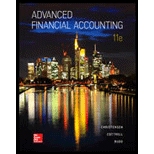
Concept explainers
1.
Introduction: Investment is the asset that is acquired for the generation of income or return in the long run. Investments are used to create capital for future utilization. The
To state: The principal business of Company I.
2.
Introduction: Investment is the asset that is acquired for the generation of income or return in the long run. Investments are used to create capital for future utilization. The return obtained from investments is used in operations of the business.
To state: The direct owners of Company I.
3.
Introduction: Investment is the asset that is acquired for the generation of income or return in the long run. Investments are used to create capital for future utilization. The return obtained from investments is used in operations of the business.
To state: The city in which Company I headquarter is situated.
4.
Introduction: Investment is the asset that is acquired for the generation of income or return in the long run. Investments are used to create capital for future utilization. The return obtained from investments is used in operations of the business.
To state: The state in which Company I is incorporated.
5.
Introduction: Investment is the asset that is acquired for the generation of income or return in the long run. Investments are used to create capital for future utilization. The return obtained from investments is used in operations of the business.
To state: The common stock of Company I is traded.
6.
Introduction: Investment is the asset that is acquired for the generation of income or return in the long run. Investments are used to create capital for future utilization. The return obtained from investments is used in operations of the business.
To state: The parent company in which Company I lease is included.
Want to see the full answer?
Check out a sample textbook solution
Chapter 4 Solutions
Advanced Financial Accounting
- Sharon Mars, a recent graduate of Bell's accounting program, evaluated the operating performance of Carla Vista Company's six divisions. Sharon made the following presentation to Carla Vista's board of directors and suggested the Percy Division be eliminated. "If the Percy Division is eliminated," she said, "our total profits would increase by $25,300." The Other Five Divisions Percy Division Total Sales $1,663,000 $100,900 $1,763,900 Cost of goods sold 978,400 76,500 1,054,900 Gross profit 684,600 24,400 709,000 Operating expenses 528,500 49,700 578,200 Net income $156,100 $(25,300 ) $130,800 In the Percy Division, cost of goods sold is $60,100 variable and $16,400 fixed, and operating expenses are $29,100 variable and $20,600 fixed. None of the Percy Division's fixed costs will be eliminated if the division is discontinued. Is Sharon right about eliminating the Percy Division? Prepare a schedule to support your answer. (Enter negative amounts using either a negative sign preceding…arrow_forwardhello tutor please help mearrow_forwardaccounting questionarrow_forward
- Mark purchased 200 shares of stock for $40 per share. During the year, he received $500 in dividends. He recently sold the stock for $55 per share. What was Mark's return on the stock? a) $3,500 b) $4,000 c) $3,900 d) $4,500arrow_forwardSummit Industries has a normal capacity of 30,000 direct labor hours. The company's variable costs are $42,000, and its fixed costs are $18,000 when running at normal capacity. What is the standard manufacturing overhead rate per unit? a) $1.50 b) $1.60 c) $2.00 d) $2.10arrow_forwardIvanhoe, Inc. has recently started the manufacture of Tri-Robo, a three-wheeled robot that can scan a home for fires and gas leaks and then transmit this information to a smartphone. The cost structure to manufacture 20,400 Tri-Robos is as follows. Cost Direct materials ($51 per robot) $1,040,400 Direct labor ($39 per robot) 795,600 Variable overhead ($7 per robot) 142,800 Allocated fixed overhead ($29 per robot) 591,600 Total $2,570,400 Ivanhoe is approached by Tienh Inc., which offers to make Tri-Robo for $116 per unit or $2,366,400. Following are independent assumptions. Assume that none of the fixed overhead can be avoided. However, if the robots are purchased from Tienh Inc., Ivanhoe can use the released productive resources to generate additional income of $375,000. (Enter negative amounts using either a negative sign preceding the number e.g. -45 or parentheses e.g. (45).) Direct materials Direct labor Variable overhead Fixed overhead Opportunity cost Purchase price Totals Make…arrow_forward
- correct answer pleasearrow_forwardcost accountingarrow_forwardSummit Holdings has $280,000 in accounts receivable that will be collected within 70 days. The company needs cash urgently and decides to factor them, receiving $260,000. Skyline Factoring Company, which took the receivables, collected $275,000 after 85 days. Find the rate of return on this investment for Skyline.arrow_forward
